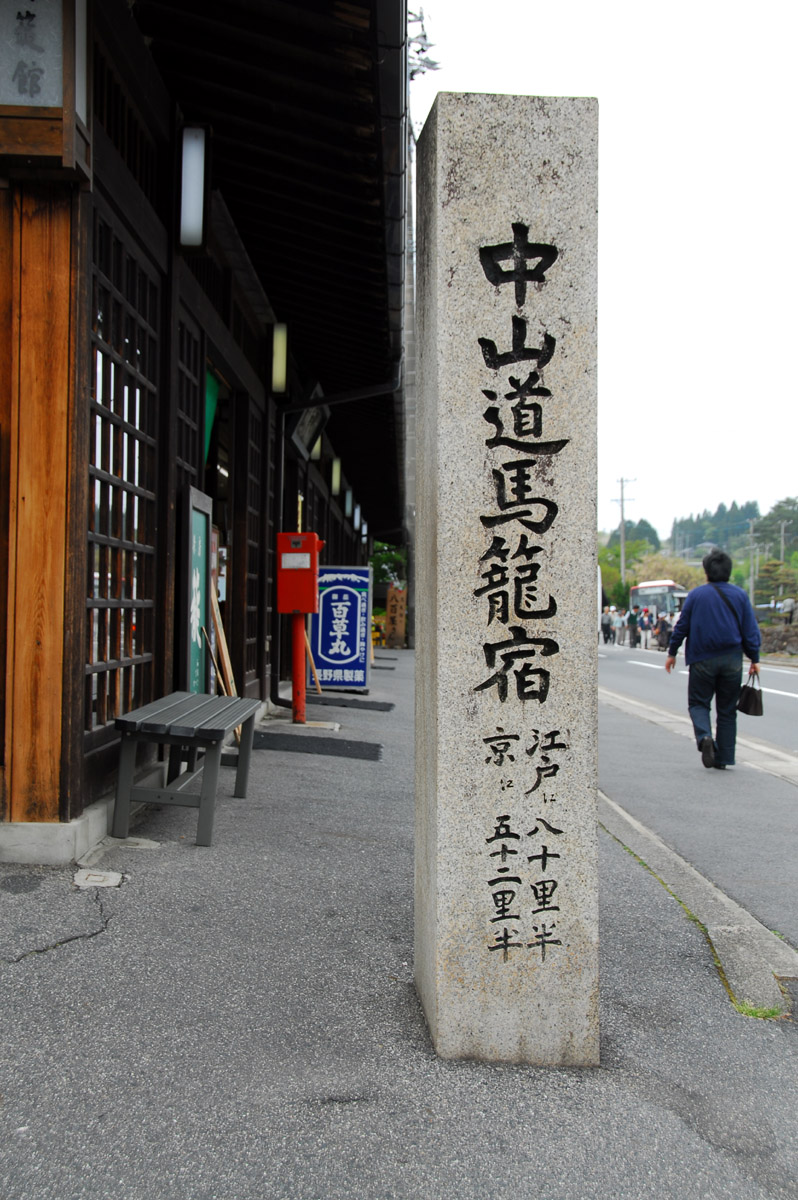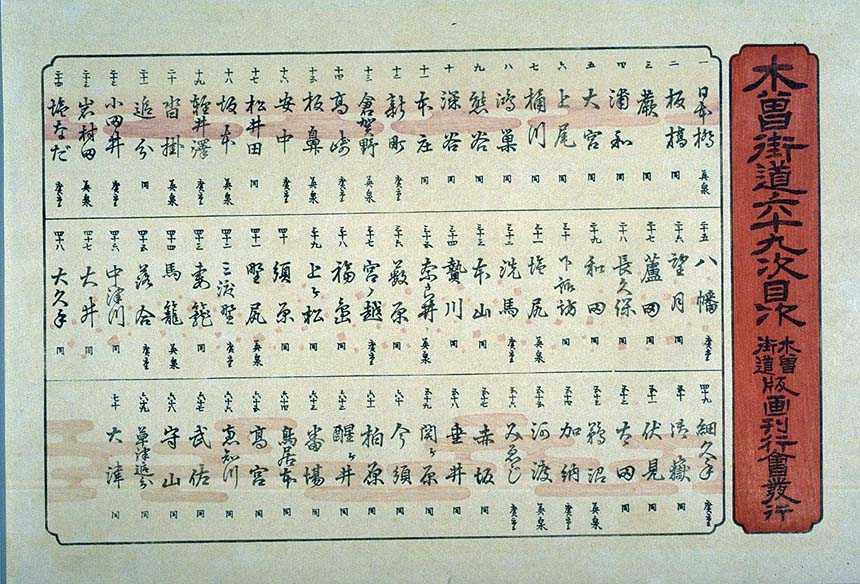|
Ochiai-juku
was the forty-fourth of the sixty-nine stations of the Nakasendō connecting Edo with Kyoto in Edo period Japan. It is located in former Mino Province in what is now part of the city of Nakatsugawa, Gifu Prefecture, Japan.Gifu Sightseeing Guide: Walking Amidst History and Nature Gifu Prefecture Tourist Federation. Accessed July 10, 2007. History Ochiai-juku is separated from to the east by the Jikkoku Pass, which marked the informal border of the "Kiso Kaido" portion of the Nakasendō highway[...More Info...] [...Related Items...] OR: [Wikipedia] [Google] [Baidu] |
The Sixty-nine Stations Of The Kiso Kaidō
The or ''Sixty-nine Stations of the Kiso Road'', is a series of ''ukiyo-e'' works created by Utagawa Hiroshige and Keisai Eisen. There are 71 total prints in the series (one for each of the 69 post stations and Nihonbashi; Nakatsugawa-juku has two prints). The common name for the Kiso Kaidō is "Nakasendō" so the series is sometimes referred to as the ''Sixty-nine Stations of the Nakasendō''. It is a follow up to Hiroshige's ''The Fifty-three Stations of the Tōkaidō'' and he produced 47 of the prints, with Eisen being responsible for the rest.Hiroshige - Kisokaido www.hiroshige.org.uk. Accessed November 1, 2017. The series was published by Iseya Rihei (Kinjudō) from .Forrer The N ...
|
Nakatsugawa-juku
was the forty-fifth of the sixty-nine stations of the Nakasendō connecting Edo with Kyoto in Edo period Japan. It is located in former Mino Province in what is now part of the city of Nakatsugawa, Gifu Prefecture, Japan.Nakatsugawa-juku . You Yuu Tokai. Accessed July 10, 2007. History Nakatsugawa-juku is located in mountainous terrain, with the Nakatsugawa river, a tributary of the flowing by the post station.. In the early , the system of ...[...More Info...] [...Related Items...] OR: [Wikipedia] [Google] [Baidu] |
69 Stations Of The Nakasendō
The are the rest areas along the Nakasendō, which ran from Nihonbashi in Edo (modern-day Tokyo) to Sanjō Ōhashi in Kyoto.Yama to Keikoku Publishing (2006). Nakasendō o Aruku (Revised ed.). Osaka: Yama to Keikoku Publishing. .Nakasendō Jōhō . NEC Corporation. Accessed August 18, 2007. The route stretched approximately and was an alternate to the Tōkaidō. 
|
Magome-juku
was the forty-third of the sixty-nine stations of the Nakasendō connecting Edo with Kyoto in Edo period Japan. It is located in former Mino Province in what is now part of the city of Nakatsugawa, Gifu Prefecture, Japan. It was also the last of eleven stations along the Kisoji, which was the precursor to a part of the Nakasendō, running through the Kiso Valley. Gifu Sightseeing Guide: Walking Amidst History and Nature Gifu Prefecture Tourist Federation. Accessed July 10, 2007. History  Magome-juku is located in a very mountainous section of the highway be ...
Magome-juku is located in a very mountainous section of the highway be ...
[...More Info...] [...Related Items...] OR: [Wikipedia] [Google] [Baidu] |
Shukuba
were post stations during the Edo period in Japan, generally located on one of the Edo Five Routes or one of its sub-routes. They were also called ''shuku-eki'' (宿駅). These post stations (or "post towns") were places where travelers could rest on their journey around the nation. They were created based on policies for the transportation of goods by horseback that were developed during the Nara and Heian periods. History These post stations were first established by Tokugawa Ieyasu shortly after the end of the Battle of Sekigahara. The first post stations were developed along the Tōkaidō (followed by stations on the Nakasendō and other routes). In 1601, the first of the Tōkaidō's fifty-three stations were developed, stretching from Shinagawa-juku in Edo to Ōtsu-juku in Ōmi Province. Not all the post stations were built at the same time, however, as the last one was built in 1624. The lodgings in the post stations were established for use by public officials an ... [...More Info...] [...Related Items...] OR: [Wikipedia] [Google] [Baidu] |
Honjin
The ''honjin'' at Ōhara-shuku.html" ;"title="Inaba Kaidō's Ōhara-shuku">Inaba Kaidō's Ōhara-shuku. is the Japanese word for an inn for government officials, generally located in post stations (''shukuba'') during the later part of the Edo period. Evolution of ''Honjin'' Originally, ''honjin'' were places from which generals directed battles and, therefore, were fleeting in nature. However, as commanders began to transform the ''honjin'' into temporary lodgings during battle and travel, ''honjin'' came to be places where ''daimyō'' and other representatives of the shogunate, including ''hatamoto'', '' monzeki'', etc., were allowed to stay during their travels. Many of the ''honjin'' were actually personal residences of village and town leaders. As such, they received official designations from the government and expanded their residences to include walls, gates and other features. Because of their cooperation, the owners of the ''honjin'' also gained various special rights. ... [...More Info...] [...Related Items...] OR: [Wikipedia] [Google] [Baidu] |
Stations Of The Nakasendō
Station may refer to: Agriculture * Station (Australian agriculture), a large Australian landholding used for livestock production * Station (New Zealand agriculture), a large New Zealand farm used for grazing by sheep and cattle ** Cattle station, a cattle-rearing station in Australia or New Zealand **Sheep station, a sheep-rearing station in Australia or New Zealand Communications * Radio communication station, a radio frequency communication station of any kind, including audio, TV, and non-broadcast uses ** Radio broadcasting station, an audio station intended for reception by the general public ** Amateur radio station, a station operating on frequencies allocated for ham or other non-commercial use ** Broadcast relay station ** Ground station (or Earth station), a terrestrial radio station for extraplanetary telecommunication with satellites or spacecraft ** Television station * Courier station, a relay station in a courier system ** Station of the ''cursus publicus'', a st ... [...More Info...] [...Related Items...] OR: [Wikipedia] [Google] [Baidu] |
Mount Ena
is a mountain peak of the Kiso Mountains range in the Chūbu region of Japan. Geography Mount Ena is in elevation. It is located on the border between Nakatsugawa in Gifu Prefecture and Achi in Nagano Prefecture. The mountain is on the list of landmark "100 Famous Japanese Mountains." The Kiso Mountains are the "Central Alps" of the scenic Japanese Alps group, located on central Honshu. Ascents Hiking routes There are four hiking routes to the summit of Mount Ena, and are the: *Kuroisawa Route (黒井沢ルート) *Misaka Pass Route (神坂峠ルート) *Hirogawara Route (広河原ルート) *Maemiya Route (前宮ルート) Summit views The Japanese Alps ranges, Mount Ontake, Mount Haku, and part of Mount Fuji can be seen from the summit of Mount Ena. File:Mount Ena Relief Map, SRTM-1.jpg, Relief Map File:Mount Fujimidai from Mount Ena 2010-12-12.jpg, The Kiso Mountains—Central Alps File:Mount Ontake and Mount Norikura from Mount Ena 2010-12-12.jpg, Mount Ontake an ... [...More Info...] [...Related Items...] OR: [Wikipedia] [Google] [Baidu] |
Kago
A is a type of litter used as a means of human transportation by the non-samurai class in feudal Japan and into the Meiji period The is an era of Japanese history that extended from October 23, 1868 to July 30, 1912. The Meiji era was the first half of the Empire of Japan, when the Japanese people moved from being an isolated feudal society at risk of colonization ... (1868–1911). Description and use The basket of a was roughly long, and attached to bamboo uprights which were suspended by a large overhead single crossbeam. A roof of some type covered the top and screens could be used to cover the sides as protection from sun or rain. A would carried by a team of four men, who would take turns carrying the on their shoulders; five or six miles could be traveled in one hour. One man would support the weight of the large overhead pole at each end and walked until he tired and switched with a rested carrier. The should not be confused with the more elaborate , wh ... [...More Info...] [...Related Items...] OR: [Wikipedia] [Google] [Baidu] |
Ukiyo-e
Ukiyo-e is a genre of Japanese art which flourished from the 17th through 19th centuries. Its artists produced woodblock prints and paintings of such subjects as female beauties; kabuki actors and sumo wrestlers; scenes from history and folk tales; travel scenes and landscapes; flora and fauna; and erotica. The term translates as "picture of the floating world". In 1603, the city of Edo (Tokyo) became the seat of the ruling Tokugawa shogunate. The '' chōnin'' class (merchants, craftsmen and workers), positioned at the bottom of the social order, benefited the most from the city's rapid economic growth, and began to indulge in and patronise the entertainment of kabuki theatre, geisha, and courtesans of the pleasure districts; the term ("floating world") came to describe this hedonistic lifestyle. Printed or painted ukiyo-e works were popular with the ''chōnin'' class, who had become wealthy enough to afford to decorate their homes with them. The earliest ukiyo-e work ... [...More Info...] [...Related Items...] OR: [Wikipedia] [Google] [Baidu] |
Utagawa Hiroshige
Utagawa Hiroshige (, also ; ja, 歌川 広重 ), born Andō Tokutarō (; 1797 – 12 October 1858), was a Japanese ''ukiyo-e'' artist, considered the last great master of that tradition. Hiroshige is best known for his horizontal-format landscape series ''The Fifty-three Stations of the Tōkaidō'' and for his vertical-format landscape series '' One Hundred Famous Views of Edo''. The subjects of his work were atypical of the ''ukiyo-e'' genre, whose typical focus was on beautiful women, popular actors, and other scenes of the urban pleasure districts of Japan's Edo period (1603–1868). The popular series '' Thirty-six Views of Mount Fuji'' by Hokusai was a strong influence on Hiroshige's choice of subject, though Hiroshige's approach was more poetic and ambient than Hokusai's bolder, more formal prints. Subtle use of color was essential in Hiroshige's prints, often printed with multiple impressions in the same area and with extensive use of '' bokashi'' (color gradation) ... [...More Info...] [...Related Items...] OR: [Wikipedia] [Google] [Baidu] |
Owari Domain
The was a feudal domain of Japan in the Edo period. Located in what is now the western part of Aichi Prefecture, it encompassed parts of Owari, Mino, and Shinano provinces. Its headquarters were at Nagoya Castle. At its peak, it was rated at 619,500 '' koku'', and was the largest holding of the Tokugawa clan apart from the shogunal lands. The Daimyō of Owari was the Owari Tokugawa family, the first in rank among the '' gosanke''. The domain was also known as History Until the end of the Battle of Sekigahara in September 1600, the area that makes up the Owari Domain was under the control of Fukushima Masanori, head of nearby Kiyosu Castle. After the battle, however, Masanori was transferred to the Hiroshima Domain in Aki Province. Leaders Sub-domains The Owari Domain was supported by the Yanagawa Domain in Mutsu Province and the Takasu Domain in Mino Province. Yanagawa Domain The Yanagawa Domain provided 30,000 ''koku'' to the Owari Domain annually from 1 ... [...More Info...] [...Related Items...] OR: [Wikipedia] [Google] [Baidu] |



_Awa_Naruto_no_fuukei.jpg)
